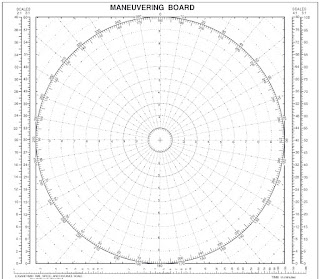Navy Story #21
Nighttime Maneuvering
On one of Pensacola's four trips across the Atlantic Ocean (twice to the Mediterranean and twice coming back from there), I remember that we (the Pensacola, I mean) had to leave
the formation (an arrangement of several ships in a specific pattern) we were in to be the target ship for some radar drills that one of the other ships was conducting for some new radar operators. Believe it or not, this
could have been on a return trip, because ships are constantly receiving new personnel, and the radar operators could easily have joined that other ship just before we sailed for home. That is my recollection, at least.
Anyway, the exercise was at night. It was a clear, calm night, with lots of stars and I think even the moon, so it was easy to see the other ships. It's amazing how much you can
see at night once your eyes have adjusted to darkness, especially out at sea, and especially when there's a moon out. It's beautiful at night out there.
After the exercise was over, of course Pensacola had to rejoin the formation we were sailing in. I recall that there were about 5 other ships with us, and we happened at the time to
be sailing in a single column, meaning that one ship was followed by another ship, which was followed by another ship, and so on. Each ship was about 1000 yards behind its leading ship, I think.
Our station in the formation was either third or fourth, so there was basically an empty slot in the column for us to come back to, between two other ships. We had sailed something
like three miles ahead of the formation, so now we had to turn around, sail down the column in the wrong direction, and turn back into our station, going back the other (original) way. This meant that we needed to do a "U"
turn and try to wind up back in our station, without either hitting the ship in front of us in the column by turning too soon, or allowing the ship behind us in the column to hit us by our turning too late. More importantly,
since the formation was fairly "loose", with lots of room between the ships, and the danger of having a collision was fairly low; being "on station" was a big deal, and in a formation like that it meant
being within 100 yards or so of the assigned position. That sounds like a lot, but it's not much when you figure that you're constantly having to make course and speed adjustments to stay in place, and ships don't
immediately respond to either course or speed adjustments.
It's much harder, compared to just staying on station when you're sailing in the same direction as the other ships, to do a "U" turn at just the right time, with just
the right amount of rudder, to be back on station after making the turn. That task fell to me that night, since I was the Junior Officer of the Deck, meaning that I was giving the helmsman and the engineering room the course
and speed instructions. It was a fun challenge. There wasn't much danger, because the formation was "loose", as I said, with lots of room between the ships. But there was a lot of potential for embarrassing
the Captain and his bridge officers if we didn't get at least fairly close to our station after the turn. The other ships' officers watch that kind of thing. We always watched the other ships to see who was on station
and who was getting a bit sloppy! I remember that the Captain said something like, "Get us close, Mr. Link." So I did some computations and course drawings on the Maneuvering Board that is on the bridge, making
use of both my training at OCS and also my knowledge of vectors and such from my study of Physics at the University of Virginia. When the time and position relative to the formation came up that I had computed for making
the turn, I gave those orders, and Pensacola swung around so she was heading the same direction as the rest of the formation. Turns like this take a minute or two with a large ship like Pensacola. When we checked our position
after the turn was done, we were, within the limits of measuring distances on our radar, exactly on station! I felt pretty good about that! The flagship even sent a coded radio message that meant "Well done", although
I can't tell you the exact message because it was coded and it's a secret. But the Captain was pleased, too, and I really enjoyed that maneuvering. There were definitely some satisfying times in the Navy!
